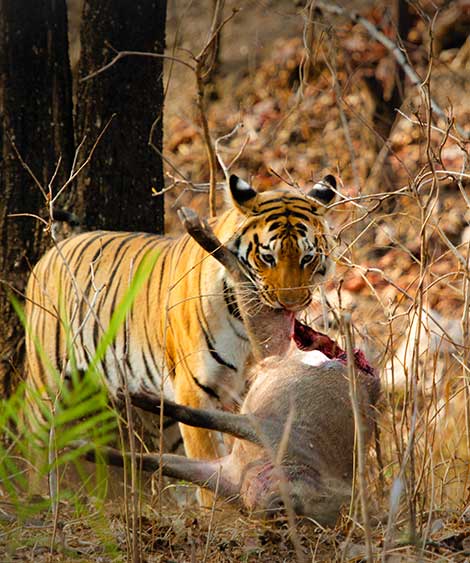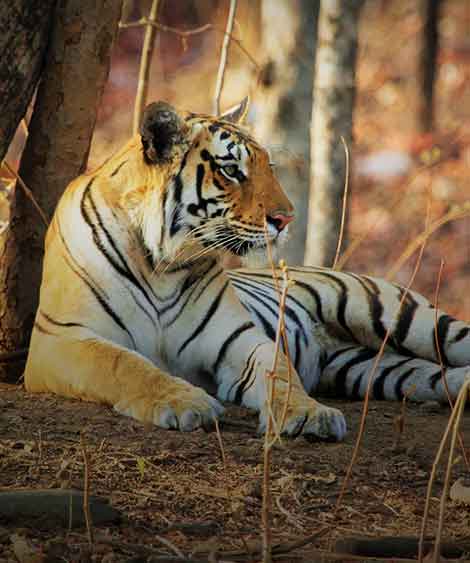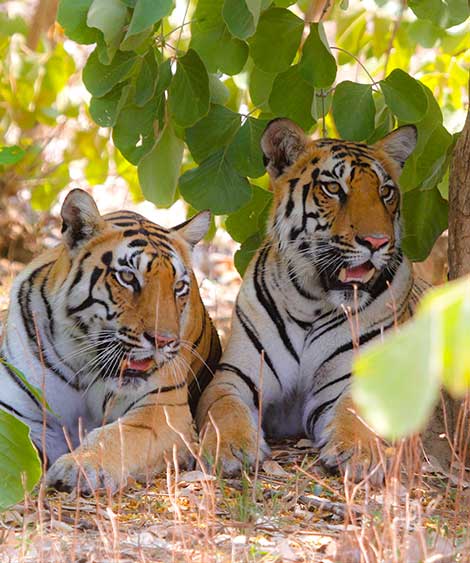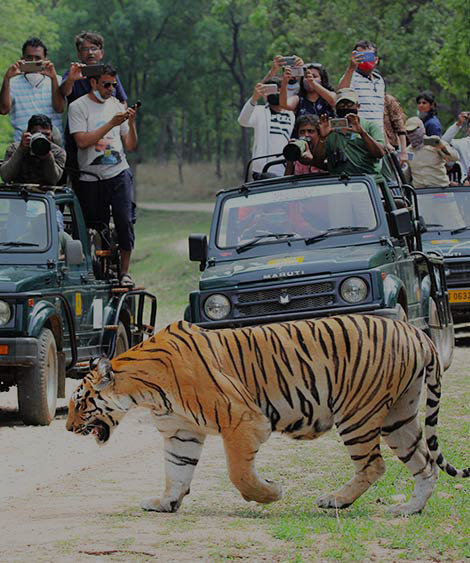
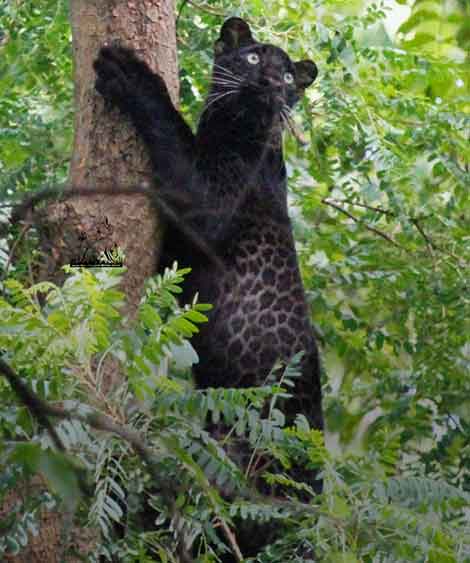
Pench
Tiger Reserve
The Pench Tiger Reserve is located in the states of Madhya Pradesh and Maharashtra in central India and is named after the Pench River. Its total area is 1919 sq km. Whose core area of Madhya Pradesh is 411 sq km and the core area of Maharashtra is 439 sq km, totaling 850 sq km. Only 20 percent of the area of this core is allowed for tourists to visit. Pench is the name of a river which flows from north to south. River has been stopped in the totladoh place of Maharashtra and a huge dam has been built. In which about 72 square kilometer area is filled with water. Which comes in the submergence area, about 54 square kilometers of water is filled in the border of Madhya Pradesh and the rest of the water is in the border of Maharashtra. Where there are different types of forests and wildlife in and around this water and the habitat of more than 100 king tigers of the forest. Here tourists from country and abroad: Forest and wildlife come here to see the beautiful scenery and the beauty of nature here.
History of Biodiversity Conservation:
The forest areas of Pench Tiger Reserve have a glorious history. Its natural beauty and richness are described in “Ain-e-Akbari”and many other natural history books like R.A. Stendal's "Seoni, Camp Life in the Satpura", Forsyth's "High Lands of Central India", Dunbar Brender's "Wild Animals of Central India". Stendhal's autobiographical book "Suture" was the main inspiration for Rudyard Kipling's writing "The Jungle Book".
Area of "The Jungle Book"
Pench Tiger Reserve and its surrounding area is the real story area of Rudyard Kipling's famous "The Jungle Book". Rudyard Kipling R.A. Stendal's book "Seoni", "Mammalia of India and Ceylon" and "Denizens of the Jungle" were made the basis for geographical structures and behavior of wild animals. Mongali was conceived from Sir William Henry Slimane's pamphlet "An Account of Wolves Nurturing Children in their Dens". In which there is a report of the capture of a boy who grew up with wolves in the year 1831 in a village named Santabavadi near Seoni. The places described in "The Jungle Book", the river Wainganga, its valley where Sher Khan was killed, the village Kanhiwada and the mountain ranges of Seoni, etc. are real places in Seoni district.
Madhya Pradesh
In the year 1977, 449.39 sq. km. The forest area was declared as Pench Sanctuary. In the year 1983, out of this, 292.850 sq. km. The area was made Pench National Park, and 118.47 sq. km. The area was kept as Pench Sanctuary. In the year 1992, 757.850 sq km by the Government of India including Pench National Park, Pench Sanctuary and some other forest areas. The area was made the country's 19th Project Tiger Reserve. In the year 2002, Pench National Park and Pench Sanctuary were renamed as Indira Priyadarshini Pench National Park and Pench Mowgli Sanctuary respectively. Between 1973 and 1988, under the Pench Hydroelectric Project, the Totladoh reservoir was constructed on the Pench river. Due to which 72 sq. km. The area came under water. Out of this, 54 sq. kms. Submergence area is in Madhya Pradesh and rest of Maharashtra.
Description of landscape:
The geographical structure of the Tiger Reserve is made up of rugged, hilly and flat areas. In which there are many rivers, streams and waterfalls. Most of the water sources here are seasonal. Most of the hills are flat from the top, from where the mesmerizing view of the forests is visible. The most famous of these hills is Kala Pahar, whose height is 650 meters above sea level. The Pench River, which flows through the middle of the Pench Tiger Reserve, almost dries up by the end of April, but there are many large pools of water found in it, which are an important water source for wildlife. There are also some perennial springs in this area. But the water source is not properly distributed, so adequate water conservation arrangements have been made for the wildlife. The Totladoh Reservoir built on the Pench River is a major water source for wildlife during the summer season.
Forest Type:
The forests found in the Pench Tiger Reserve are divided into three parts as follows: -
South Indian Tropical Moist Deciduous Forest (Simple Moist)
Southern Tropical Dry Deciduous Teak Forest
southern tropical dry deciduous mixed forest
Dry mixed forest covers about one-third of the area of the protected area. Whose main species are Dhavda, Salai, Pickle, Moyan, Saja, Tendu etc. Kahua (Arjuna), Jamun, Gular, Ixora and Saja etc. are found on the banks of river drains. In the open forests of the displaced areas of old villages, trees of mahua, palash, ber, tendu etc. are found scattered here and there. Teak forests are found in about one-fourth of the area. Bamboo is also found in some mixed and teak forests.
Grass is found in abundance in most of the forest areas. Adequate amount of grass also grows in teak forests. Which is a suitable habitat for vegetarian wildlife especially chital.
Vegetation and Wildlife:
Lion, leopard, wild cat, wild dog, hyena, jackal, fox, wolf, mongoose, civet cat etc. are found in carnivorous wildlife. The vegetarian species include gaur, nilgai, sambar, chital, chaisinga, chinkara, wild boar etc.
Ramukh is About 325 species of birds can also be seen in this national park in different seasons of the year. The submergence areas of the totladoh Reservoir located inside the park boundary are home to many types of migratory birds during the winter season. Brahmini duck, pintail, whistling teal, wagtail etc. are prominent among the migratory birds.
About 57 species of mammals, 13 types of amphibians, 37 types of reptiles and 52 types of fishes have been detected in this protected area after a survey in this regard by the Zoological Survey of India. Along with this, more than 325 species of birds have been identified in different types of habitats.
Members of invertebrates are also found in large numbers in this national park and sanctuary. So far, 5 species of termites, 13 types of insects, 33 types of beetles, 125 types of butterflies and 56 types of moths have been identified in the survey
This region is also very rich in terms of vegetation. About 31 species of trees of high height, 52 species of medium type trees and 65 species of low height trees are found. Along with this, 120 types of shrubs and 485 types of herbaceous plants are also found in different habitats. Not only this, 72 types of important vines can also be seen in this forest. 8 types of parasites and 3 types of epiphytes are also found. About 127 species of medicinal plants have been identified. Safed Musli, Kali Musli, Wild Turmeric, Asparagus, Giloy, Athi, Amla, Bael, Baheda and many other species of valuable medicinal plants are found in this beautiful forest.
Different species of grasses play an important role in natural ecosystems. About 82 types of grass species are found in this forest area. Bamboo is also found in some areas like Kala Pahad, Bamboo Nala, Mannu Talab, Boda Nala etc.
Indira Priyadarshini Pench National Park and Mongali Pench Sanctuary area mainly consists of teak forests. Along with teak, there are trees of Saja, Dhavda, Lendia, Salai, Dhoban, Tendu, Bija, Garari, Kullu, Amla, Dhaman, Dhont, Amaltas, Bhirra and Palas species.

